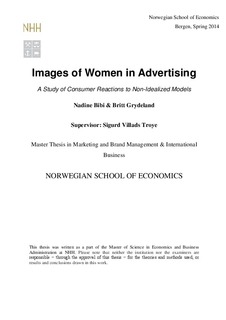| dc.description.abstract | In a world where the public is constantly bombarded by commercial messages, marketers must rapidly innovate their communication methods in order to capture consumers’ attention and affection. Both advertisers and magazines have been criticized of late for the use of overly airbrushed, digitally altered models that appear impossibly perfect. The use of these images has increasingly been called into question, creating an opportunity for certain brands to capitalize on the idea of using ‘real women’ in their marketing communications.
The literature currently available on the use of real women in advertising is limited as the phenomenon is relatively recent. There are, however, multiple studies that examine how consumers respond to atypical models which deviate from the norm in attractiveness levels, weight or ethnic group. This thesis will aim to fill some of the theoretical gaps in the body of knowledge about the use of non-idealized women in advertising and seek to more fully understand how consumers’ attitudes and purchase intentions are affected by their use, as well as examining whether or not the consumers’ culture plays a role in formulating these judgements.
This study shows that consumers exhibit stronger attitude towards the ad, brand attitude and purchase intentions when exposed to a non-idealized model who they find more likeable and attractive than to those who do not. Models whose appearances are less shocking to the viewers are better received, indicating that aspirational images, rather than assimilative ones, still play a role in positively influencing consumer behaviour.
Furthermore, this study approached the issue of using non-idealized models in advertising from a cultural viewpoint as well and it was found that there are significant differences between cultures in the strength of their reactions to the models. Though the general patterns of behaviour remain similar, individuals from different cultures express varying levels of acceptance to the idea of using non-traditional models in marketing campaigns.
The results of this thesis provide a foundation upon which future research into the idea of using models which deviate from the typical ‘beauty ideal’ can be based and provide a broader understanding of the concept as compared to previous research. | nb_NO |
